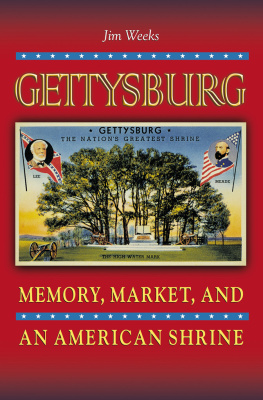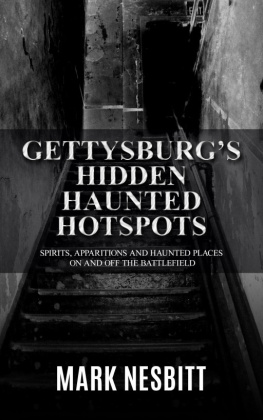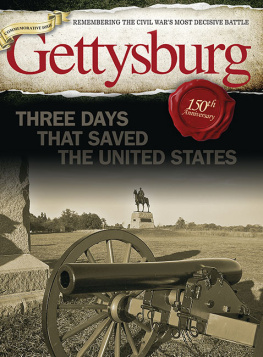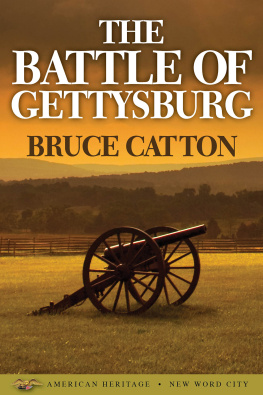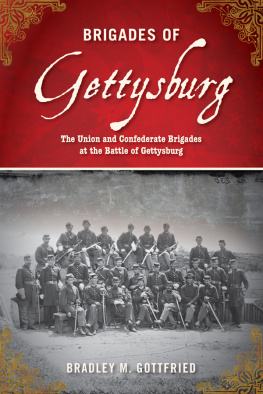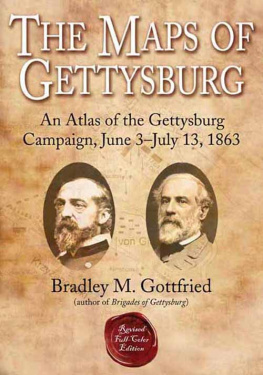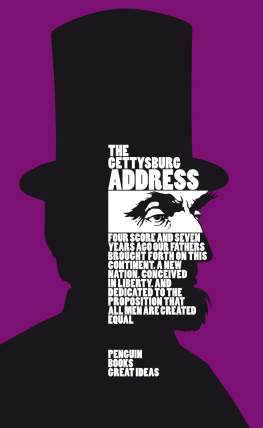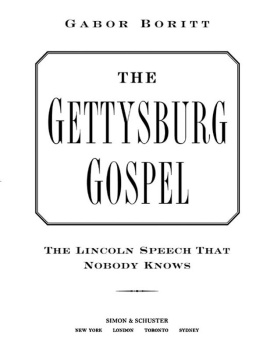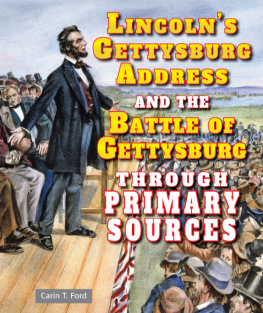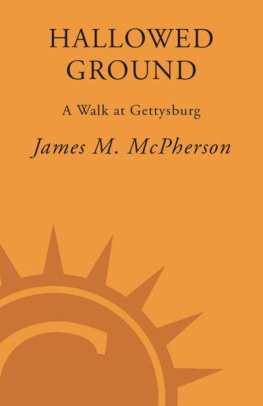
GETTYSBURG
Jim Weeks
GETTYSBURG

MEMORY, MARKET, AND AN AMERICAN SHRINE
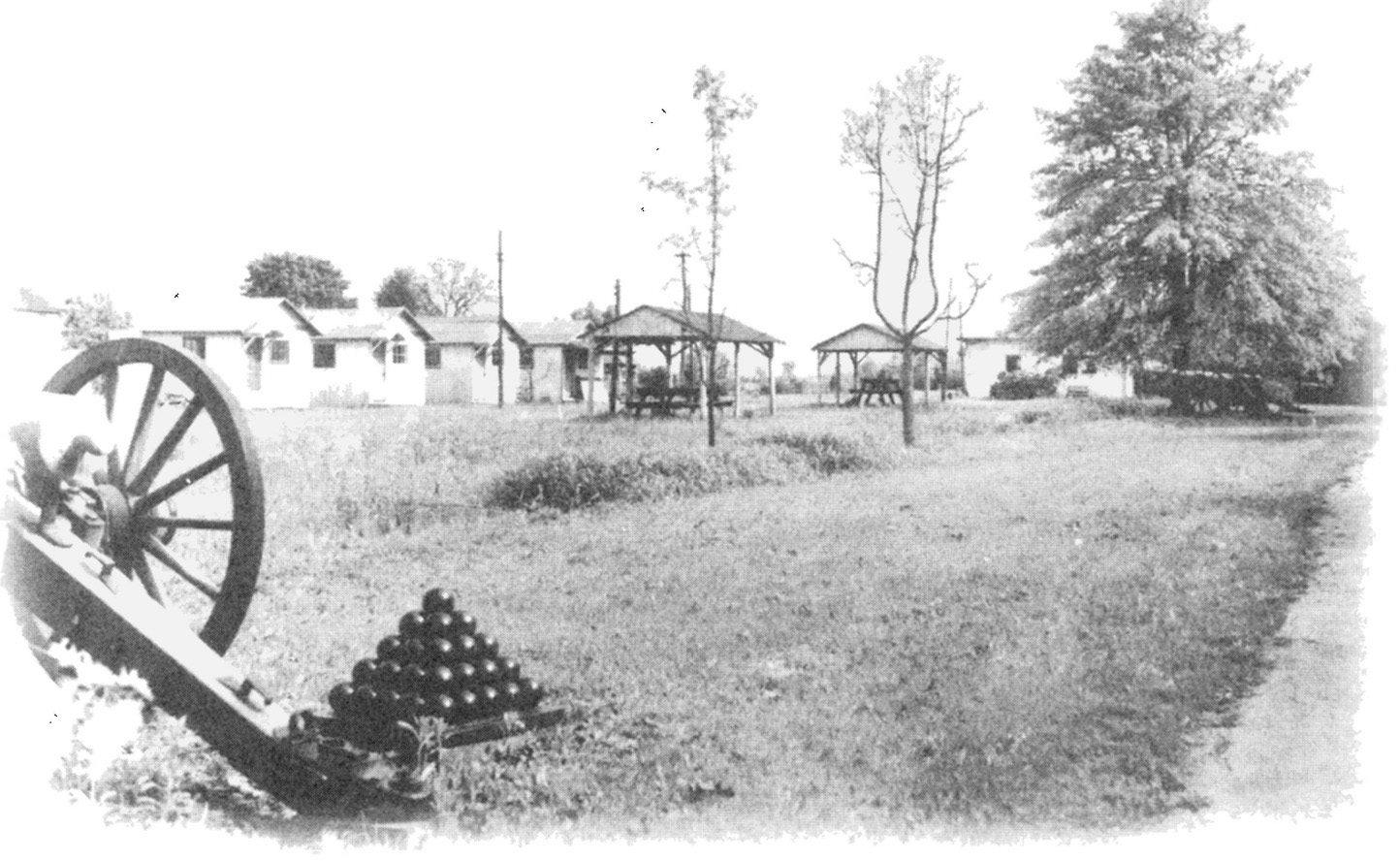
PRINCETON UNIVERSITY PRESS . PRINCETON AND OXFORD
Copyright 2003 by Princeton University Press
Published by Princeton University Press, 41 William Street, Princeton, New Jersey 08540
In the United Kingdom: Princeton University Press, 3 Market Place,
Woodstock, Oxfordshire Ox20 isy
ALL RIGHTS RESERVED
Library of Congress Cataloging-in-Publication Data
Weeks, Jim, 1950
Gettysburg : memory, market, and an American shrine / by Jim Weeks.
p. cm.
Includes bibliographical references (p.) and index.
ISBN 0-691-14445-1 (alk. paper)
eISBN 978-1-400-83254-5
1. Gettysburg National Military Park (Pa.) 2. Gettysburg, Battle of, Gettysburg, Pa.,
1863. 3. TourismSocial aspectsPennsylvaniaGettysburg. 4. Heritage
tourismPennsylvaniaGettysburg. 5. MemorySocial
aspectsPennsylvaniaGettysburg. 6. Historic sitesEconomic
aspectsPennsylvaniaGettysburg. 7. PennsylvaniaHistoryCivil War,
1861-1865Monuments. 8. United StatesHistoryCivil War, 1861-1865Monuments.
I. Title.
E475.56 .w44 2003
973-7'349dc21 2002074911
British Library Cataloging-in-Publication Data is available
https://press.princeton.edu
R0

A GETTYSBURG SOUVENIR
FOR GARY S. CROSS
Illustrations

Acknowledgments

ALONG the pilgrimage route that ended again at Gettysburg, I met many a friend without whose aid the journey would not have continued. The Department of History provided generous support through a Hill Fellowship in 1997, and subsequently funded travel to deliver papers at national meetings. In search of research material I traveled as far south as Durham, as far north as Worcester, and as far west as Chicago. Although it is not possible to individually thank those who contributed to my research, all were most cordial and helpful in spite of often straitened circumstances. Many doggedly tracked down materials and took time to discuss my project far beyond the requirements of their institutions. These people include, in alphabetical order, Louise Arnold, U.S. Army War College, Carlisle, Pennsylvania; Fred Bauman, Jr., Manuscript Division, Library of Congress, Washington, D.C.; Woody Christ, Adams County Historical Society, Gettysburg; Robert Sayre Cox, and Brian Dunnigan, Clements Library, University of Michigan; John Coski, Museum of the Confederacy, Richmond; Sue Hamburger, Penn State Special Collections; Scott Hartwick, Gettysburg National Military Park; David Hedrick, Gettysburg College; Randy Roberts, Western Historical Manuscript Collection, University of Missouri-Columbia; Paul Romaine and Sandra Trenholm, Gilder-Lehrman Collection, New York; Jane Sferra, Ohio Historical Society; Chris Dupin, Princeton University Library Department of Rare Books and Special Collections; Mark Van Ells, Wisconsin Veterans Museum, Madison, Wisconsin; Steve Wright, Civil War Library and Museum, Philadelphia; and Helena Wright, Smithsonian Institution. Kathy Georg Harrison of Gettysburg National Military Park and her colleague Winona Peterson deserve special thanks for allowing me access to the parks archives. They graciously accommodated my presence in their cramped quarters off and on for nearly a year.
I also take this opportunity to thank a number of helpful employees of the following institutions whose names are unknown to me: Chicago Historical Society; College of William and Mary Special Collections, Williamsburg, Virginia; Historical Society of Pennsylvania, Philadelphia; National Archives and Records Administration, Washington, D.C., and Philadelphia; National Library of Medicine, Bethesda, Maryland; Newberry Library, Chicago; Pennsylvania State Archives and Library, Harrisburg; Perkins Library Special Collections, Duke University, Durham; Southern Collection, University of North Carolina, Chapel Hill; University of Wisconsin Special Collections; and Wisconsin Historical Society, Madison.
Thanks also to Gettysburgians Jackie White, Thelma Dick, and Vera Culver, who shared family papers, photographs, and reminiscences. Carleton Smith and Katie Lawhon of the Gettysburg National Park Service and Susan Robertson of Friends of the National Parks at Gettysburg most graciously allowed me to borrow photographs. David Meskers of Strasburg, Pennsylvania opened his extensive collection of Gettysburg materials for my use. The staff of Penn States Interlibrary Loan cheerfully provided innumerable reels of microfilm and other research materials month after month. I owe both thanks and apologies to the student employees of the microforms department, whom I often delayed after closing time. Some students even thought I worked there.
Several fine minds provided motivation and helped refine the ideas in this study. David Blight of Amherst College as well as William Pencak and Anne C. Rose of Penn State contributed valuable suggestions in spite of their often frenetic schedules. Gary Gallagher of the University of Virginia not only provided much advice during the projects early stages, but aided access to several archives and historical societies. His encouragement and comments often kept the fires burning. To Gary Cross of Penn State, I apply President James Garfields remark that his idea of an education was Mark Hopkins, president of Garfields alma mater, Williams College, on one end of a log and me on the other. Gary continuously nurtured this project with inspiration as well as invaluable ideas from his fertile mind. Nevertheless, I will repeat the second biggest clich cited in books built on the kindness of others, that none of those who assisted along the journey are in any way responsible for technical or judgmental errors.
Finally, my family kept me going materially and spiritually. Moose, Alice, and Phil graciously shared space while offering companionship. My wife, Beth, often turned drudgery into fun, proved a model traveling companion, and needless to say demonstrated much patience. My mother-in-law, Teddy, supported this effort in several important ways, not the least of which was a keen sense of humor when levity seemed in short supply. Jack, Jay, and Bess accompanied me on trips to Gettysburg, and their observations proved most insightful. I also owe much to Boots and Judi, who were part of the initial pilgrimage to Gettysburg over forty years ago and, although we cannot escape beings relatives, are still my friends. Most of all I owe a debt to my mother and father, Catherine Weeks and L. James Weeks. They not only continually provided spiritual and material sustenance, their belief in the culture of aspiration encouraged curiosity about the world, cultural capital for which I am much indebted.

